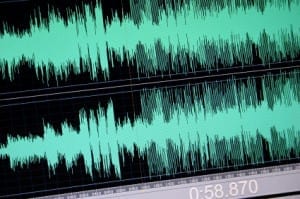What is Dithering and How Can it Benefit Your Home Recording
Dither may be one of the least understood effects available in recording software. However, it can be very important when used correctly, so it’s important to understand exactly what dithering is and how to use it.
What is Dithering?

Dither gets into some pretty technical areas of digital recorded sound, but we’ll keep this guide focused on what it actually does for your recordings, and when it should be used. Though it seems counter-intuitive, dither is actually the adding of noise to an audio track. This very low level noise cancels out (to our ears) small amounts of distortion caused by reducing the bit-rate of digital recordings.
When recording, you’re typically working in high resolution (24-bit resolution, for example), but most playback options are lower resolution. For example, a CD only supports 16-bit resolution playback. So when your songs are mastered to the lower resolution for export to CD, the loss in resolution comes through in slight distortion that can create a grainy sound on your songs.
Dither Smooths Out the Digital Noise
This unwanted grainy sound is specifically called “quantization distortion” or “quantization error,” and results because lower resolutions support less sound information -- particularly volume information.
The low level of noise dither adds essentially fills in the “holes” in your lower resolution audio track that cause that grainy and gritty sound. It smooths out the sound, providing a track that is nearly identical to the original source track.
When to Use Dither (and When Not To)
Because it is not well known by many, it can be tempting to play around with dither while you are recording. But dithering is meant to be used in the mastering process, not for individual tracks in your recording session. Adding even the slightest amount of noise to your recording is not ideal, since we spend a large amount of time in our home studios trying to get rid of any excess noise. As you can imagine, adding that small amount of excess noise to individual tracks will result in a larger amount of noise that won’t actually do anything to help your recording.
In fact, it is somewhat of an ongoing argument among engineers whether dither should be used in all cases in the mastering process. We think the real answer lies in what best serves each song, and that’s the approach we take to every song we work on during our online mastering process.
A High Resolution Future
The best solution to dither would be to require no dither at all. That would mean we have audio formats that support the higher resolution audio that wouldn’t result in quantization distortion in the first place. We’ve written about Neil Young's support of the Pono format which has a 24-bit depth. The problem comes in with the fact that though a higher resolution format is ideal, Mp3 players, smartphone and computer won’t support it, so we still have to deal with digital distortion.
But with digital audio always advancing, it’s likely we could see a widespread, high resolution solution sooner rather than later. Until that happens, you may want to keep dither in your plugin library.




